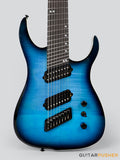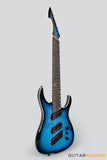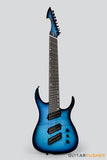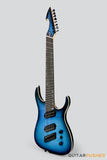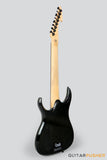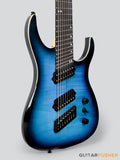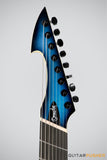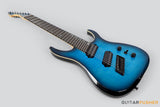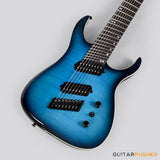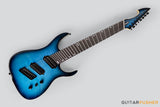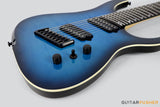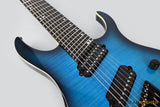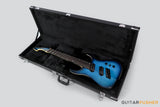Ormsby Hype GTR 8-String Multiscale Electric Guitar Sophia Blue
Product Description
ORMSBY GUITARS - HYPE GTR
The Ormsby Guitars Hype GTR is our production version of the coveted Hypemachine made in our Australian custom shop. For many years now this modern guitar model has been turning heads the world over for its balanced aggressive looks. The Hype GTR is designed to meet the needs and demands of modern guitarists.
It features a modern deep carve set-neck that allows players to have unhindered access to all 24 stainless steel frets. We included our most popular custom shop neck carve; a balanced D shape with round shoulders that provides just the right feel and 'meat' to the neck and a perfect thumb resting position.
As with all our GTR models, the Hype GTR utilises our Australian custom shop designed pickups that produce a variety of tones that allow your guitar, effects, and amp to function in unison and retain their individual characteristics. This guitar can go from the cleanest cleans to the heaviest of metals (or djents!) with plenty of tones in between thanks to its coil-splitting options.
Perhaps the most important feature of this modern instrument, it uses our Multiscale design that was developed from the ground up over 10 years ago. Simply put, it improves the tonality, ergonomics, and overall playing experience of the guitar (read more here), and can handle even the most unique of modern tunings.
Every Hype GTR uses our custom designed hardware built to our high demands in quality, including our unique multiscale bridge, locking tuners and O-Ring controls. Also included with every GTR model is a fitted and embossed hard case so your guitar is always safe.
Available in 6, 7, and 8 strings.
It features a modern deep carve set-neck that allows players to have unhindered access to all 24 stainless steel frets. We included our most popular custom shop neck carve; a balanced D shape with round shoulders that provides just the right feel and 'meat' to the neck and a perfect thumb resting position.
As with all our GTR models, the Hype GTR utilises our Australian custom shop designed pickups that produce a variety of tones that allow your guitar, effects, and amp to function in unison and retain their individual characteristics. This guitar can go from the cleanest cleans to the heaviest of metals (or djents!) with plenty of tones in between thanks to its coil-splitting options.
Perhaps the most important feature of this modern instrument, it uses our Multiscale design that was developed from the ground up over 10 years ago. Simply put, it improves the tonality, ergonomics, and overall playing experience of the guitar (read more here), and can handle even the most unique of modern tunings.
Every Hype GTR uses our custom designed hardware built to our high demands in quality, including our unique multiscale bridge, locking tuners and O-Ring controls. Also included with every GTR model is a fitted and embossed hard case so your guitar is always safe.
Available in 6, 7, and 8 strings.
WHAT IS MULTISCALE?
FIRST - SOME HISTORY
|
The whole Multiscale guitar design came about after talking with guitarists who were looking for the ultimate in tone. I'd built some baritones, but tuned as regular guitars. The tone was huge. There was a downside though; the extended scale length meant that soloing was more difficult.
One thing that always fascinated me, was the fact that most musical instruments (drums, pipe organs, pianos, horns, etc) all used a large 'object' for the lower notes. A piano string is considerably longer for the lower notes, than those used for the higher pitches. A kick drum is physically larger than a snare, and the same goes for cymbals, etc. |
I started looking at how a guitar could be adapted to suit. In the beginning, it was two totally different scale lengths, the E/A/D strings had one, and the G/B/E had another. However, this would be impossible to play.
Then one day it hit me, if I used the centreline of the neck as the basis of a scale length, and made the frets splay out in a fanned direction, it could work. That night, I discovered an instrument called an opharion. It was perfect. Exactly what I'd imagined. |
|
From there, I started designing. Knowing how even the best guitars are still out of tune with themselves, I worked out which frets to move, or 'misplace' to increase accuracy. I studied guitarists and how they move on stage, to develop the best angles for the nut and bridge. I calculated the best position for the 'straight' fret, based on how most guitarist play when sitting or standing. It was coming together pretty well, and I was proud of what I'd discovered.
Once the design was finalised, I started showing people. No one understood it. For years I explained the theory, but no one was interested. Then one day, someone said "oh, they look like they are fanned frets", which sent me on a discovery of the new term. I found an instrument maker in the USA, who was making 'fanned fret' guitars, although he wasn't angling the bridge, nor the pickups. I continued with designing the Multiscale... it would need specific hardware, the headstock had to be angled differently, the pickups needed to be custom built, and a whole bunch of other little bits and pieces. |
The whole thing got put on the back burner for a few years until I found a client brave enough to want to try it out. Once we signed off on the design, it all happened very quickly, about 15 days in fact.
It was amazing. So natural to play. The tone was unbelievable. The sustain! I was absolutely thrilled to pieces with how it played. |
MULTISCALES - ALL THE DETAILS
|
DIMENSIONS
For a guitar or bass, the fanned arrangement of the Multiscale fretboard creates scale lengths for each individual string. We generally call this the "spread". For Ormsby Guitars, the spread is as follows: Six string: 25.5" - 27.5" Seven string: 25.5" - 27.8" Eight String: 25.5" - 28.2" Due to the increased scale length on the bass side, the tension of the strings increases. We recommend you try dropping a gauge on the bottom end, for example, if you usually use 9-46's, try 9-42's. As of the 2017 production year we have commenced making an additional style of multiscale that allows for standard hardware to be used, and places the 'neutral' fret at the bridge. Currently these are spread as follows: Six string: 25.5" - 26.5" Seven string: TBA Eight string: TBA FEEL When either seated or standing, the natural position for most guitarists 'at rest' aligns with the 9th fret. We call this the 'straight fret'. Moving this straight fret position, to let's say, the 12th fret, causes issues towards the nut, or moving it to the 8th, 7th or even 6th fret, increases the angle of the bridge, and therefore the pickup. Both not really a good idea. The nut angle is aligned with the natural flow of your forearm AND your unbent wrist. Try this; grab your guitar, and play an F bar chord. You'll notice your wrist is bent nearly to the full extent of its movement, stretching tendons. With a Multiscale, this is not the case. Your wrist stays straight (although some players still play the 'old way') which in turn means you no longer stretch those tendons and muscles. Player fatigue? Thing of the past! The same theory is in place at the bridge. Stand in front of a mirror and lightly palm mute your strings at the bridge. See how you'll have to bend back in an unnatural way to palm mute more than a few strings? The Multiscale bridge is angled to suit the natural resting angle of your forearm. |
HARDWARE
The bridges are custom made for us to exacting tolerances by Hipshot Products USA. We are very proud to have them as our partners in production of hardware for both our custom shop and GTR range of guitars as their quality is second to none. TONE There is one thing most people notice straight away when playing a Multiscale. The tone. The increased tension improves tone. If you've ever put a larger set of strings on your guitar, you'll notice the tone was a little fatter. This is more due to the increase of the string tension, rather than the physical dimension of the string. There is a point of diminished return on a regular guitar... if the strings are too big, the sustain suffers. Imagine a bass string on a guitar; the string dimension has increased, the string tension has increased, but the string physically cannot vibrate for as long. A longer scale length solves this issue. TUNING Consider a Multiscale as a normal guitar. You tune it the same. Bends are as per normal. However, intonation is more accurate. The bass side strings do not stretch as much when you hit them with a plectrum, so you don't get as much pitch increase in the initial attack of the note. |


